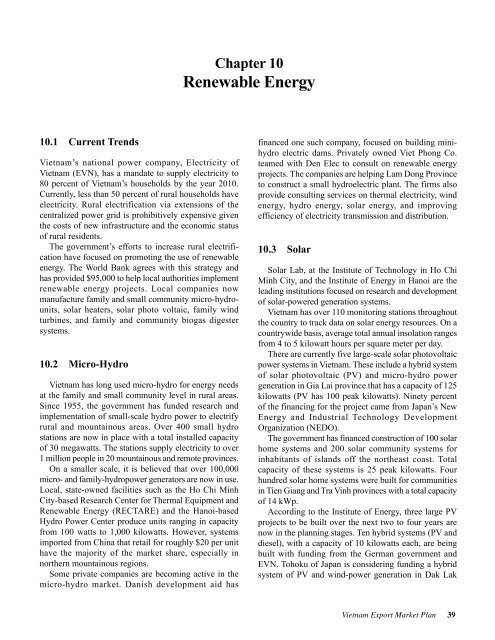Vietnam Environmental Technologies Export Market Plan
Vietnam Environmental Technologies Export Market Plan
Vietnam Environmental Technologies Export Market Plan
You also want an ePaper? Increase the reach of your titles
YUMPU automatically turns print PDFs into web optimized ePapers that Google loves.
Chapter 10<br />
Renewable Energy<br />
10.1—Current Trends<br />
<strong>Vietnam</strong>’s national power company, Electricity of<br />
<strong>Vietnam</strong> (EVN), has a mandate to supply electricity to<br />
80 percent of <strong>Vietnam</strong>’s households by the year 2010.<br />
Currently, less than 50 percent of rural households have<br />
electricity. Rural electrification via extensions of the<br />
centralized power grid is prohibitively expensive given<br />
the costs of new infrastructure and the economic status<br />
of rural residents.<br />
The government’s efforts to increase rural electrification<br />
have focused on promoting the use of renewable<br />
energy. The World Bank agrees with this strategy and<br />
has provided $95,000 to help local authorities implement<br />
renewable energy projects. Local companies now<br />
manufacture family and small community micro-hydrounits,<br />
solar heaters, solar photo voltaic, family wind<br />
turbines, and family and community biogas digester<br />
systems.<br />
10.2—Micro-Hydro<br />
<strong>Vietnam</strong> has long used micro-hydro for energy needs<br />
at the family and small community level in rural areas.<br />
Since 1955, the government has funded research and<br />
implementation of small-scale hydro power to electrify<br />
rural and mountainous areas. Over 400 small hydro<br />
stations are now in place with a total installed capacity<br />
of 30 megawatts. The stations supply electricity to over<br />
1 million people in 20 mountainous and remote provinces.<br />
On a smaller scale, it is believed that over 100,000<br />
micro- and family-hydropower generators are now in use.<br />
Local, state-owned facilities such as the Ho Chi Minh<br />
City-based Research Center for Thermal Equipment and<br />
Renewable Energy (RECTARE) and the Hanoi-based<br />
Hydro Power Center produce units ranging in capacity<br />
from 100 watts to 1,000 kilowatts. However, systems<br />
imported from China that retail for roughly $20 per unit<br />
have the majority of the market share, especially in<br />
northern mountainous regions.<br />
Some private companies are becoming active in the<br />
micro-hydro market. Danish development aid has<br />
financed one such company, focused on building minihydro<br />
electric dams. Privately owned Viet Phong Co.<br />
teamed with Den Elec to consult on renewable energy<br />
projects. The companies are helping Lam Dong Province<br />
to construct a small hydroelectric plant. The firms also<br />
provide consulting services on thermal electricity, wind<br />
energy, hydro energy, solar energy, and improving<br />
efficiency of electricity transmission and distribution.<br />
10.3—Solar<br />
Solar Lab, at the Institute of Technology in Ho Chi<br />
Minh City, and the Institute of Energy in Hanoi are the<br />
leading institutions focused on research and development<br />
of solar-powered generation systems.<br />
<strong>Vietnam</strong> has over 110 monitoring stations throughout<br />
the country to track data on solar energy resources. On a<br />
countrywide basis, average total annual insolation ranges<br />
from 4 to 5 kilowatt hours per square meter per day.<br />
There are currently five large-scale solar photovoltaic<br />
power systems in <strong>Vietnam</strong>. These include a hybrid system<br />
of solar photovoltaic (PV) and micro-hydro power<br />
generation in Gia Lai province that has a capacity of 125<br />
kilowatts (PV has 100 peak kilowatts). Ninety percent<br />
of the financing for the project came from Japan’s New<br />
Energy and Industrial Technology Development<br />
Organization (NEDO).<br />
The government has financed construction of 100 solar<br />
home systems and 200 solar community systems for<br />
inhabitants of islands off the northeast coast. Total<br />
capacity of these systems is 25 peak kilowatts. Four<br />
hundred solar home systems were built for communities<br />
in Tien Giang and Tra Vinh provinces with a total capacity<br />
of 14 kWp.<br />
According to the Institute of Energy, three large PV<br />
projects to be built over the next two to four years are<br />
now in the planning stages. Ten hybrid systems (PV and<br />
diesel), with a capacity of 10 kilowatts each, are being<br />
built with funding from the German government and<br />
EVN. Tohoku of Japan is considering funding a hybrid<br />
system of PV and wind-power generation in Dak Lak<br />
<strong>Vietnam</strong> <strong>Export</strong> <strong>Market</strong> <strong>Plan</strong><br />
39
















